Dislocation-Governed Plastic Deformation and Fracture Toughness of Nanotwinned Magnesium
Abstract
:1. Introduction
2. Simulation Models and Method
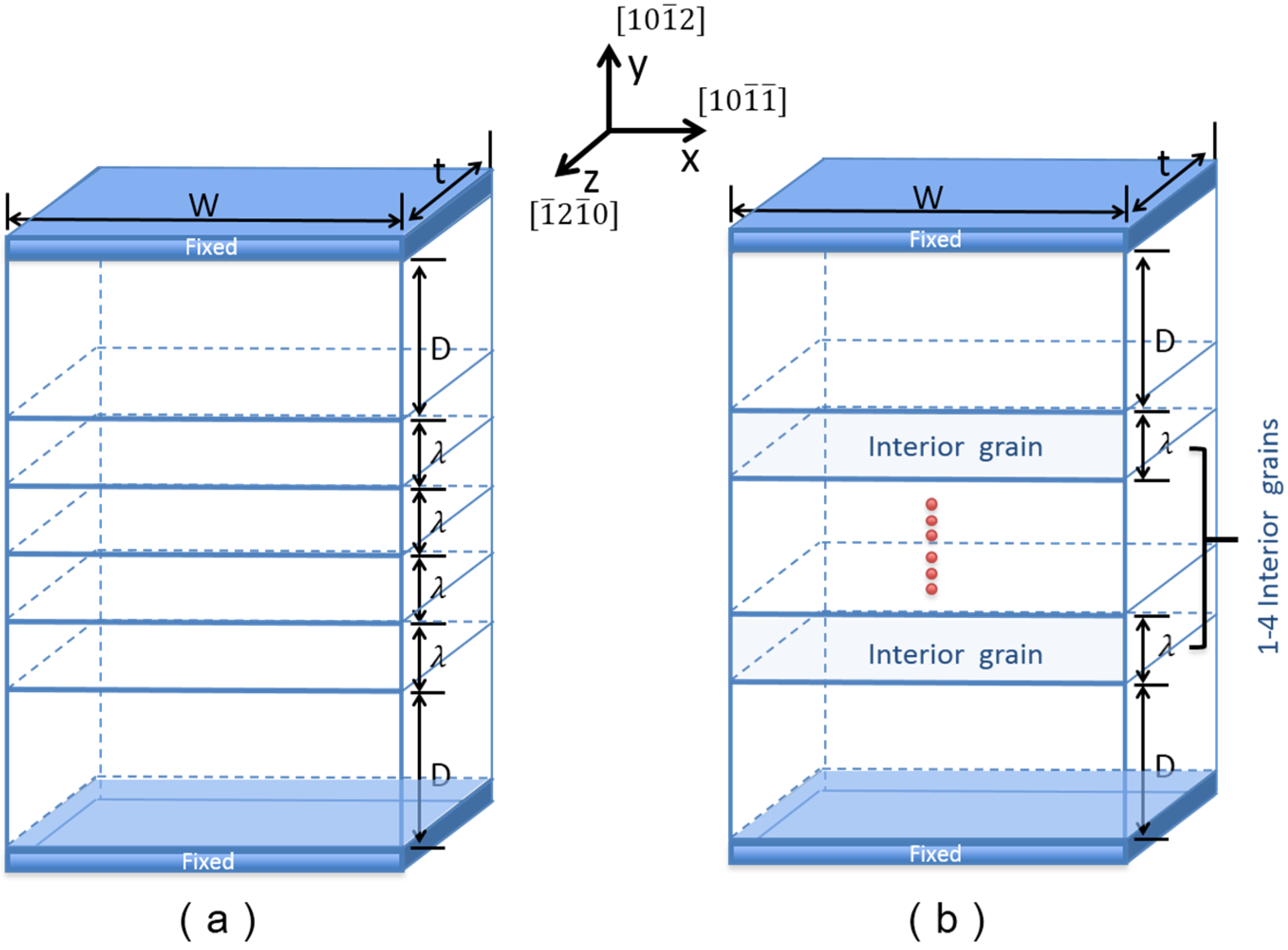
| λ (nm) | D (nm) | W (nm) | t (nm) | Number of Atoms |
|---|---|---|---|---|
| 5 | 16 | 40 | 2.4 | 159,368 |
| 7.5 | 16 | 40 | 2.4 | 191,368 |
| 10 | 16 | 40 | 2.4 | 235,520 |
| 12 | 16 | 40 | 2.4 | 268,088 |
| 13.5 | 16 | 40 | 2.4 | 299,720 |
| 15.5 | 16 | 40 | 2.4 | 320,256 |
3. Results and Analysis
3.1. Left Edge Crack (LEC) Model vs. Right Edge Crack (REC) Model
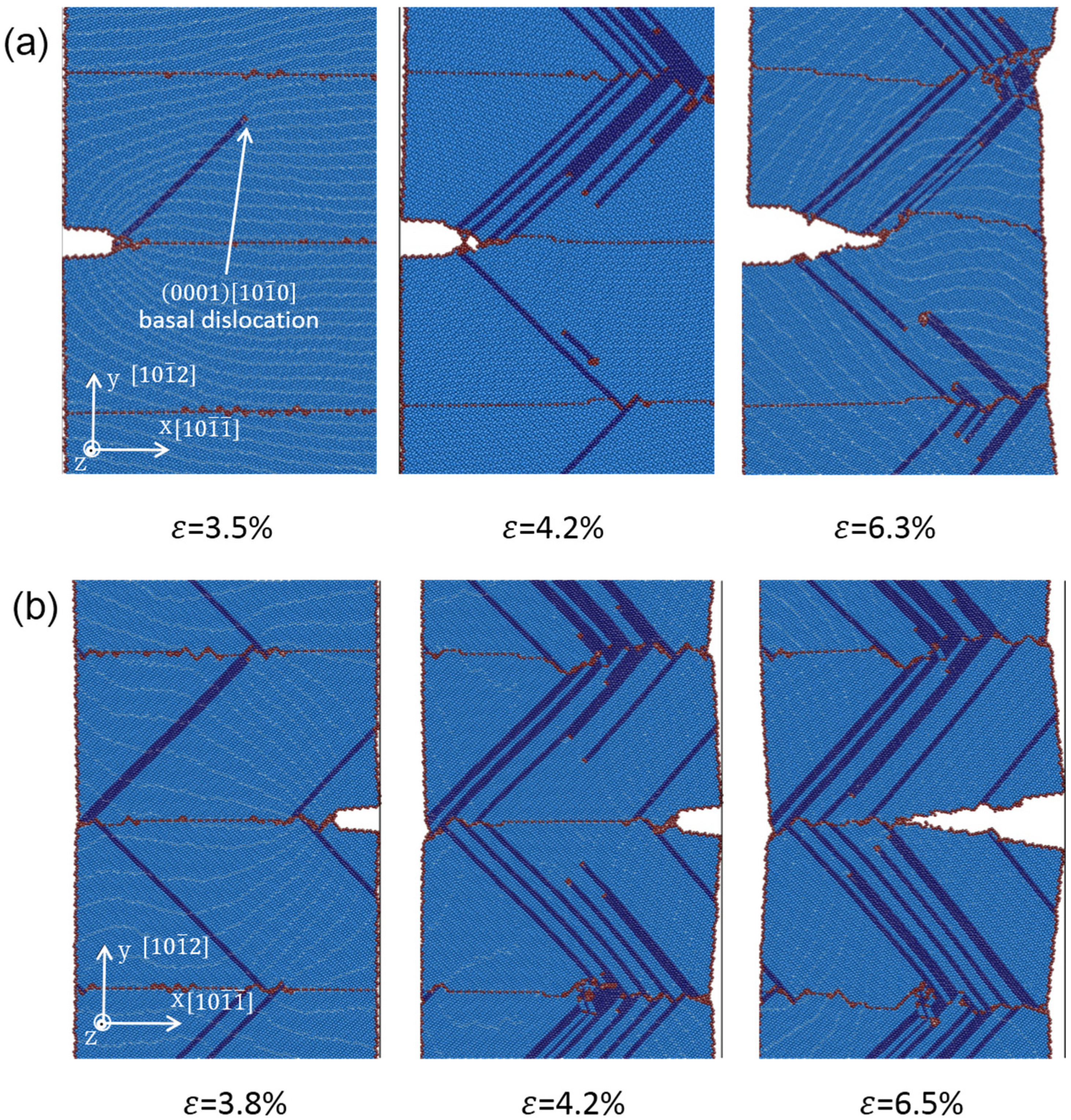
| Crack | ν | ɸ | θ | γ usf (J/m2) | Gdisl (J/m2) |
|---|---|---|---|---|---|
| LEC | 0.31 | 0 | 43 | 0.092 | 0.914 |
| REC | 0.31 | 0 | 137 | 0.092 | 5.888 |

3.2. Effect of TB Spacing on Crack Propagation
3.2.1. Stress-Strain Curves

3.2.2. Atomistic Configurations
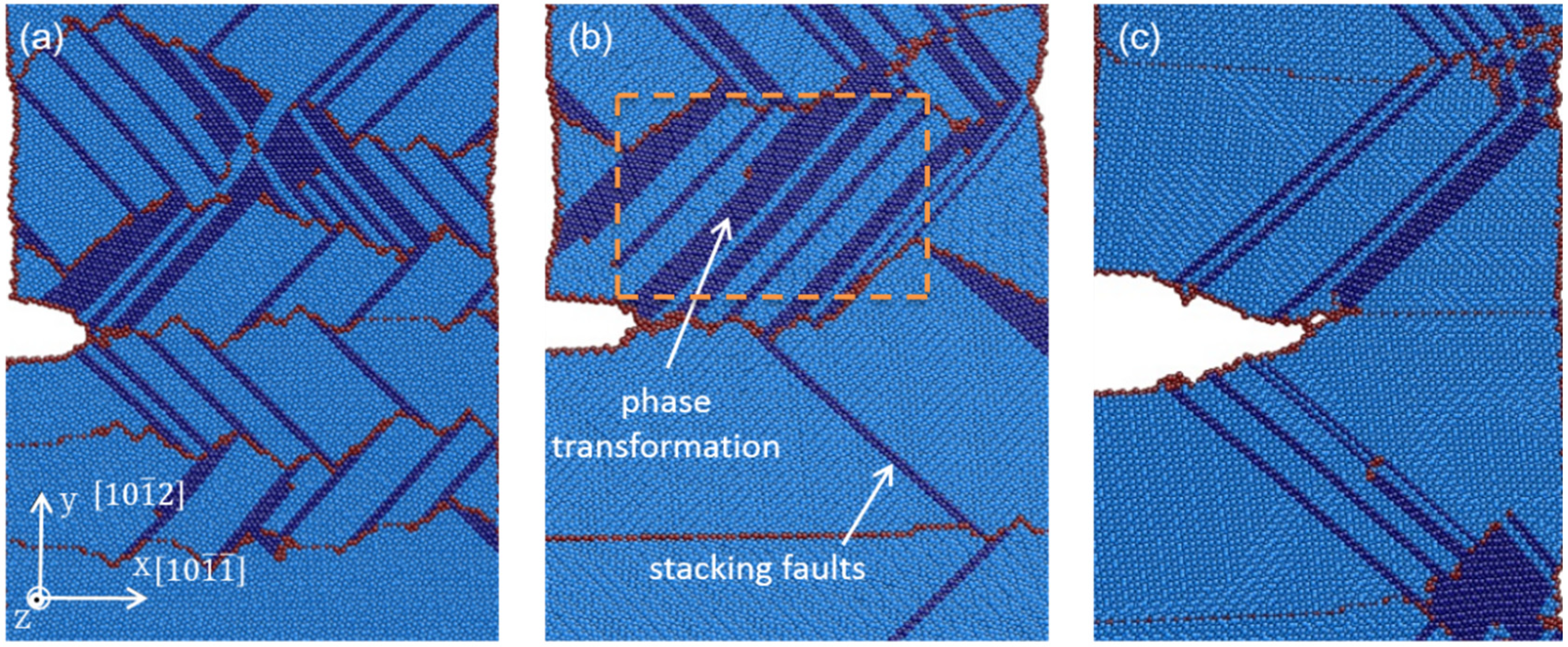
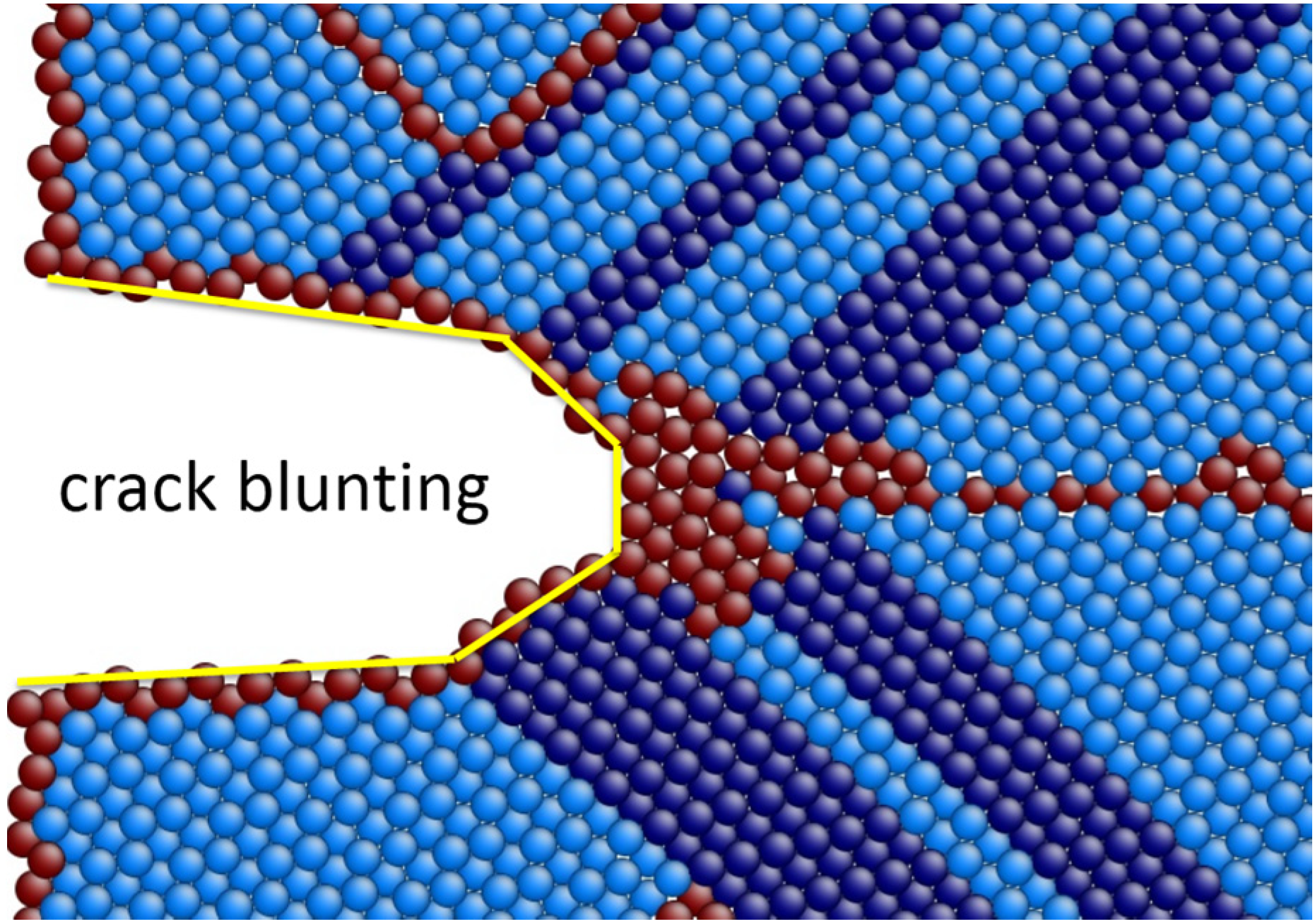

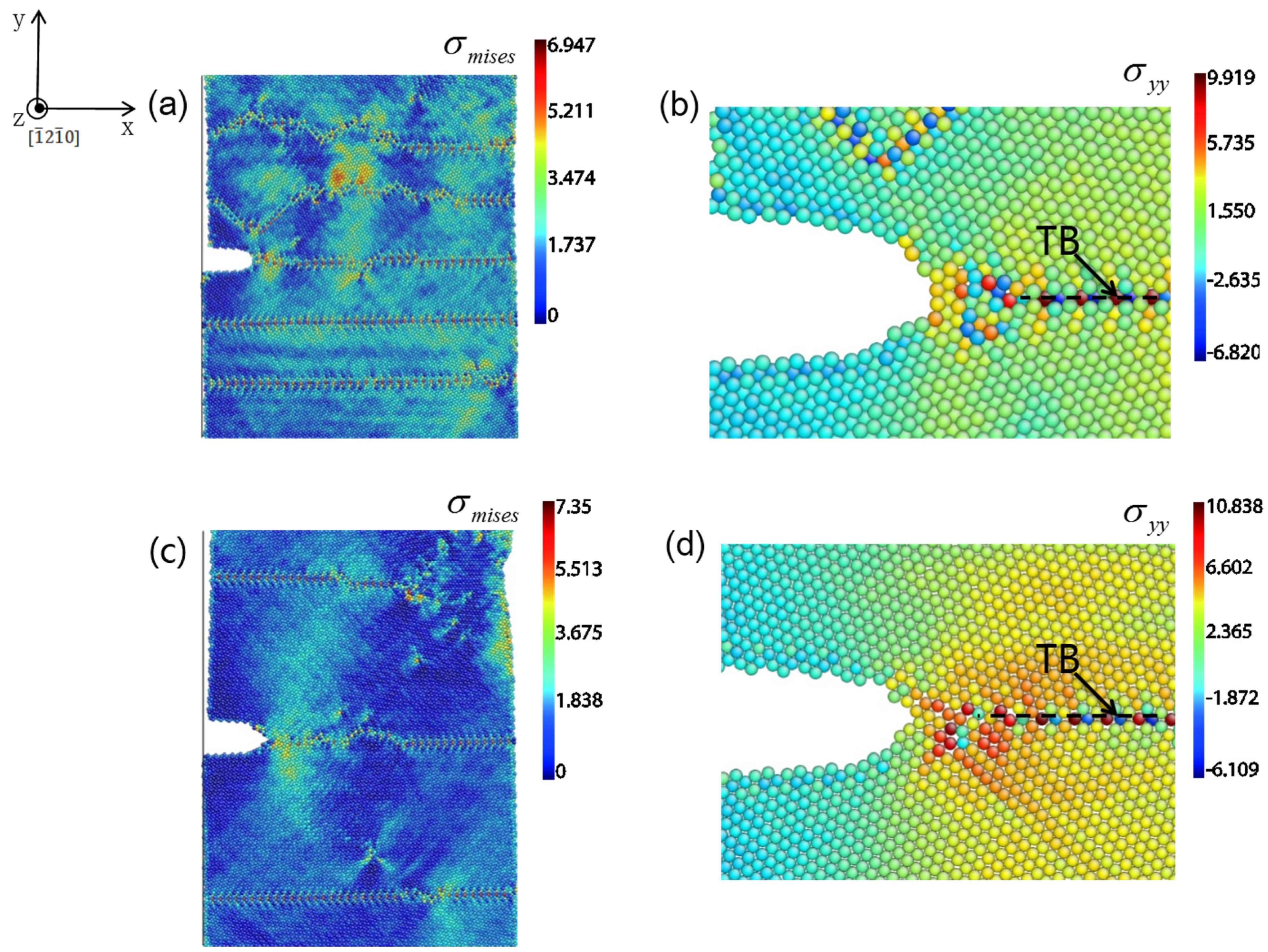
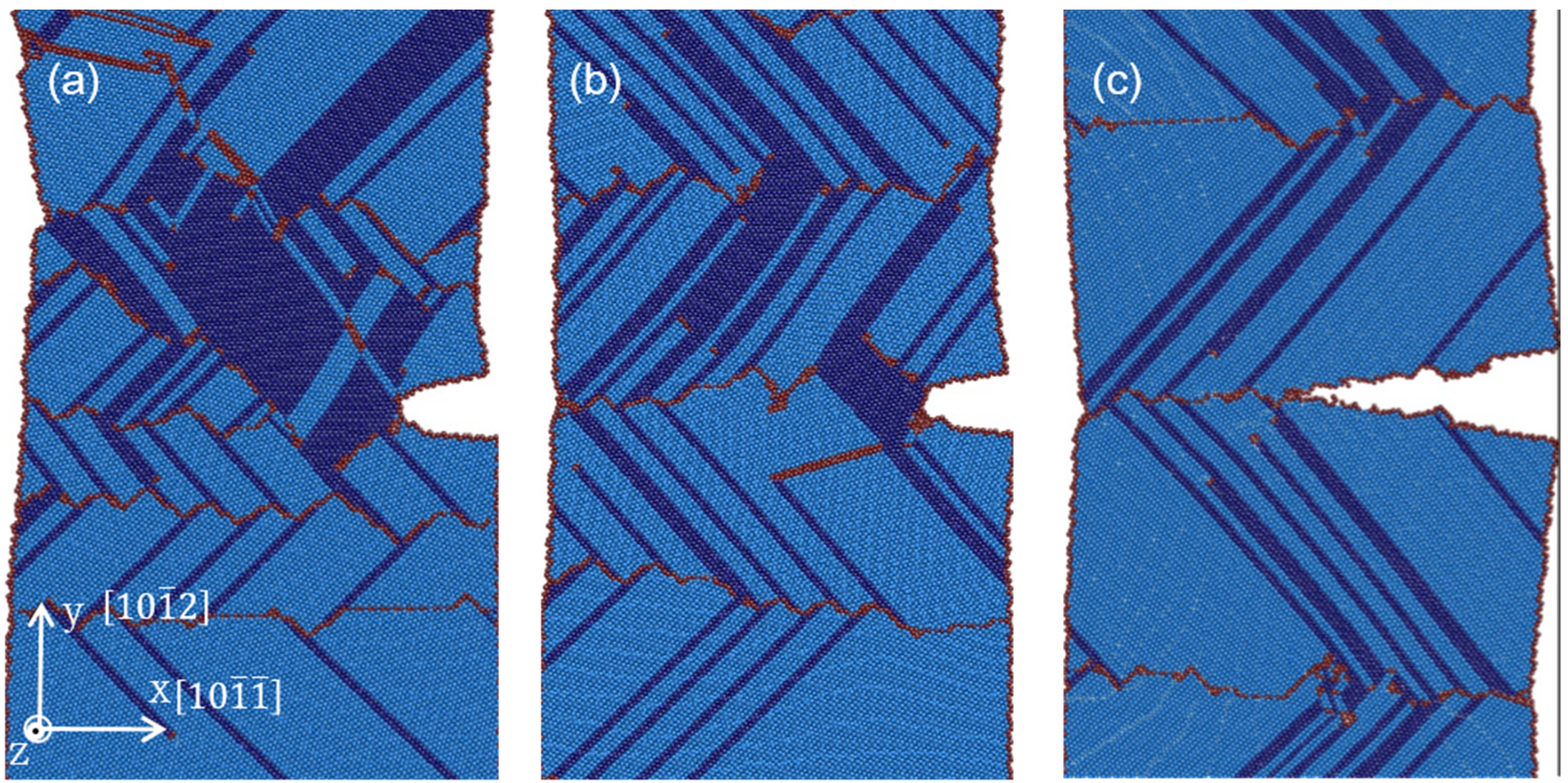
3.3. Dislocation Density vs. Fracture Toughness
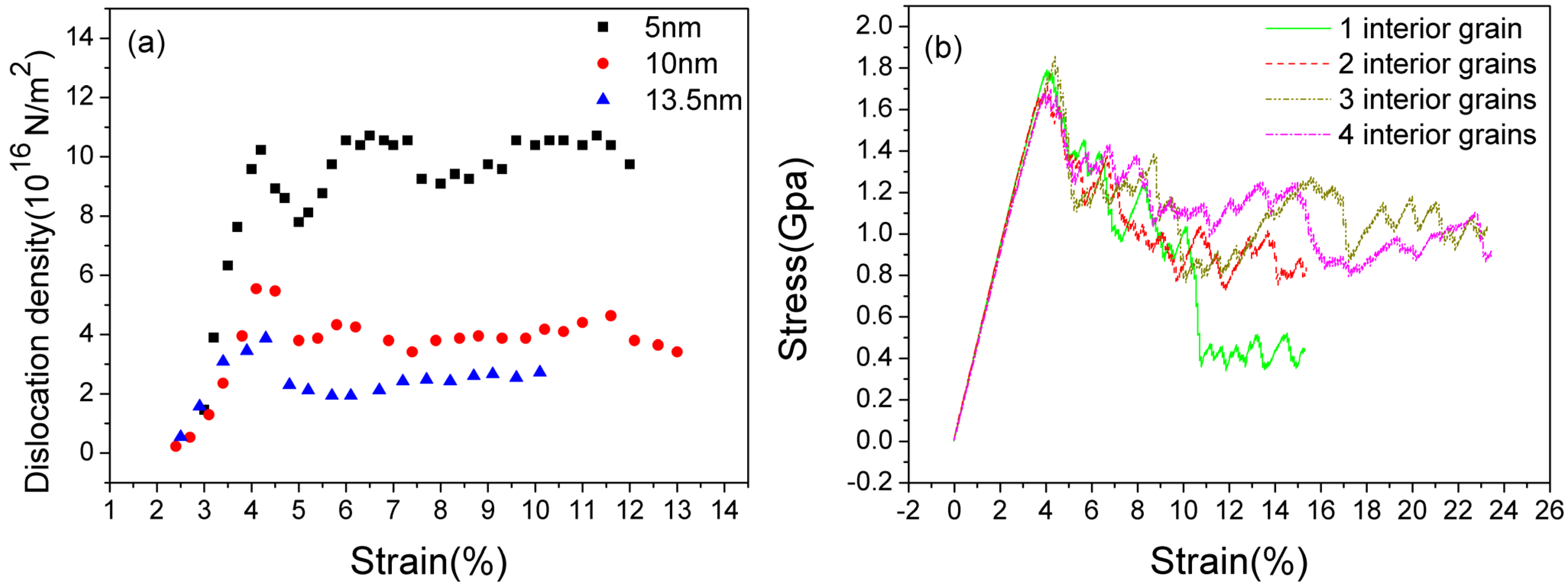
4. Conclusions
Acknowledgments
Author Contributions
Conflicts of Interest
References
- Dalla Torre, F.; Lapovok, R.; Sandlin, J.; Thomson, P.F.; Davies, C.H.J.; Pereloma, E.V. Microstructures and properties of copper processed by equal channel angular extrusion for 1–16 passes. Acta Mater. 2004, 52, 4819–4832. [Google Scholar] [CrossRef]
- Iwasaki, H.; Higashi, K.; Nieh, T.G. Tensile deformation and microstructure of a nanocrystalline Ni-W alloy produced by electrodeposition. Scr. Mater. 2004, 50, 395–399. [Google Scholar] [CrossRef]
- Meyers, M.A.; Mishra, A.; Benson, D.J. Mechanical properties of nanocrystalline materials. Prog. Mater. Sci. 2006, 51, 427–556. [Google Scholar] [CrossRef]
- Wang, Y.M.; Sansoz, F.; LaGrange, T.; Ott, R.T.; Marian, J.; Barbee, T.W., Jr.; Hamza, A.V. Defective twin boundaries in nanotwinned metals. Nat. Mater. 2013, 12, 697–702. [Google Scholar] [CrossRef] [PubMed]
- Mirshams, R.A.; Xiao, C.H.; Whang, S.H.; Yin, W.M. R-curve characterization of the fracture toughness of nanocrystalline nickel thin sheets. Mater. Sci. Eng. A 2001, 315, 21–27. [Google Scholar] [CrossRef]
- Li, Y.S.; Tao, N.R.; Lu, K. Microstructural evolution and nanostructure formation in copper during dynamic plastic deformation at cryogenic temperatures. Acta Mater. 2008, 56, 230–241. [Google Scholar] [CrossRef]
- Zhang, X.; Wang, H.; Chen, X.H.; Lu, L.; Lu, K.; Hoagland, R.G.; Misra, A. High-strength sputter-deposited cu foils with preferred orientation of nanoscale growth twins. Appl. Phys. Lett. 2006, 88. [Google Scholar] [CrossRef]
- Sun, H.Q.; Shi, Y.N.; Zhang, M.X.; Lu, K. Plastic strain-induced grain refinement in the nanometer scale in a Mg alloy. Acta Mater. 2007, 55, 975–982. [Google Scholar] [CrossRef]
- Yu, Q.; Qi, L.; Chen, K.; Mishra, R.K.; Li, J.; Minor, A.M. The nanostructured origin of deformation twinning. Nano Lett. 2012, 12, 887–892. [Google Scholar] [CrossRef] [PubMed]
- Pozuelo, M.; Mathaudhu, S.N.; Kim, S.; Li, B.; Kao, W.H.; Yang, J.M. Nanotwins in nanocrystalline Mg-Al alloys: An insight from high-resolution tem and molecular dynamics simulation. Philos. Mag. Lett. 2013, 93, 640–647. [Google Scholar] [CrossRef]
- Lu, L.; Chen, X.; Huang, X.; Lu, K. Revealing the maximum strength in nanotwinned copper. Science 2009, 323, 607–610. [Google Scholar] [CrossRef] [PubMed]
- Song, B.; Guo, N.; Liu, T.T.; Yang, Q.S. Improvement of formability and mechanical properties of magnesium alloys via pre-twinning: A review. Mater. Des. 2014, 62, 352–360. [Google Scholar] [CrossRef]
- Song, H.Y.; Li, Y.L. Effect of twin boundary spacing on deformation behavior of nanotwinned magnesium. Phys. Lett. A 2012, 376, 529–533. [Google Scholar] [CrossRef]
- Qin, E.W.; Lu, L.; Tao, N.R.; Lu, K. Enhanced fracture toughness of bulk nanocrystalline Cu with embedded nanoscale twins. Scr. Mater. 2009, 60, 539–542. [Google Scholar] [CrossRef]
- Hong, S.G.; Park, S.H.; Lee, C.S. Role of {10–12} twinning characteristics in the deformation behavior of a polycrystalline magnesium alloy. Acta Mater. 2010, 58, 5873–5885. [Google Scholar] [CrossRef]
- Song, B.; Xin, R.L.; Sun, L.Y.; Chen, G.; Liu, Q. Enhancing the strength of rolled ZK60 alloys via the combined use of twinning deformation and aging treatment. Mater. Sci. Eng. A 2013, 582, 68–75. [Google Scholar] [CrossRef]
- Tang, T.; Kim, S.; Horstemeyer, M.F. Fatigue crack growth in magnesium single crystals under cyclic loading: Molecular dynamics simulation. Comput. Mater. Sci. 2010, 48, 426–439. [Google Scholar] [CrossRef]
- Serra, A.; Bacon, D.J.; Pond, R.C. Twins as barriers to basal slip in hexagonal-close-packed metals. Metall. Mater. Trans. A 2002, 33, 809–812. [Google Scholar] [CrossRef]
- Christian, J.W.; Mahajan, S. Deformation twinning. Prog. Mater. Sci. 1995, 39, 1–157. [Google Scholar] [CrossRef]
- Wu, X.L.; Qi, Y.; Zhu, Y.T. Partial-mediated slips in nanocrystalline Ni at high strain rate. Appl. Phys. Lett. 2007, 90. [Google Scholar] [CrossRef]
- Liu, X.Y.; Adams, J.B.; Ercolessi, F.; Moriarty, J.A. Eam potential for magnesium from quantum mechanical forces. Model. Simul. Mater. Sci. Eng. 1996, 4, 293–303. [Google Scholar] [CrossRef]
- Kim, D.H.; Ebrahimi, F.; Manuel, M.V.; Tulenko, J.S.; Phillpot, S.R. Grain-boundary activated pyramidal dislocations in nano-textured Mg by molecular dynamics simulation. Mater. Sci. Eng. A 2011, 528, 5411–5420. [Google Scholar] [CrossRef]
- Kim, D.H.; Manuel, M.V.; Ebrahimi, F.; Tulenko, J.S.; Phillpot, S.R. Deformation processes in-textured nanocrystalline Mg by molecular dynamics simulation. Acta Mater. 2010, 58, 6217–6229. [Google Scholar] [CrossRef]
- Li, B.; Ma, E. Zonal dislocations mediating twinning in magnesium. Acta Mater. 2009, 57, 1734–1743. [Google Scholar] [CrossRef]
- Plimpton, S. Fast parallel algorithms for short-range molecular dynamics. J. Comput. Phys. 1995, 117, 1–19. [Google Scholar] [CrossRef]
- Faken, D.; Jónsson, H. Systematic analysis of local atomic structure combined with 3D computer graphics. Comput. Mater. Sci. 1994, 2, 279–286. [Google Scholar] [CrossRef]
- Li, J. Atomeye: An efficient atomistic configuration viewer. Model. Simul. Mater. Sci. Eng. 2003, 11. [Google Scholar] [CrossRef]
- Rice, J.R. Dislocation nucleation from a crack tip: An analysis based on the peierls concept. J. Mech. Phys. Solids 1992, 40, 239–271. [Google Scholar] [CrossRef]
- Muzyk, M.; Pakiela, Z.; Kurzydlowski, K.J. Generalized stacking fault energy in magnesium alloys: Density functional theory calculations. Scr. Mater. 2012, 66, 219–222. [Google Scholar] [CrossRef]
- Zhu, T.; Li, J.; Samanta, A.; Kim, H.G.; Suresh, S. Interfacial plasticity governs strain rate sensitivity and ductility in nanostructured metals. Proc. Natl. Acad. Sci. 2007, 104, 3031–3036. [Google Scholar] [CrossRef] [PubMed]
- Serra, A.; Bacon, D.J. A new model for {1012} twin growth in hcp metals. Philos. Mag. A 1996, 73, 333–343. [Google Scholar] [CrossRef]
- Jang, D.; Li, X.; Gao, H.; Greer, J.R. Deformation mechanisms in nanotwinned metal nanopillars. Nat. Nano 2012, 7, 594–601. [Google Scholar] [CrossRef] [PubMed]
- Yuan, F.P.; Wu, X.L. Atomistic scale fracture behaviours in hierarchically nanotwinned metals. Philos. Mag. 2013, 93, 3248–3259. [Google Scholar] [CrossRef]
© 2015 by the authors; licensee MDPI, Basel, Switzerland. This article is an open access article distributed under the terms and conditions of the Creative Commons Attribution license (http://creativecommons.org/licenses/by/4.0/).
Share and Cite
Zhou, L.; Guo, Y.-F. Dislocation-Governed Plastic Deformation and Fracture Toughness of Nanotwinned Magnesium. Materials 2015, 8, 5250-5264. https://doi.org/10.3390/ma8085250
Zhou L, Guo Y-F. Dislocation-Governed Plastic Deformation and Fracture Toughness of Nanotwinned Magnesium. Materials. 2015; 8(8):5250-5264. https://doi.org/10.3390/ma8085250
Chicago/Turabian StyleZhou, Lei, and Ya-Fang Guo. 2015. "Dislocation-Governed Plastic Deformation and Fracture Toughness of Nanotwinned Magnesium" Materials 8, no. 8: 5250-5264. https://doi.org/10.3390/ma8085250






